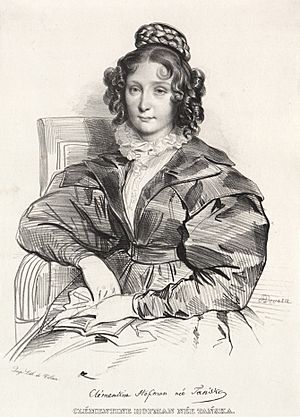Klementyna Hoffmanowa facts for kids
Quick facts for kids
Klementyna Hoffmanowa
|
|
|---|---|
 |
|
| Born | Klementyna Tańska November 23, 1798 Warsaw |
| Died | September 21, 1845 (aged 46) Passy near Paris |
| Resting place | Père Lachaise Cemetery |
| Occupation | Novelist |
| Language | Polish |
| Nationality | Polish |
| Period | 19th century |
| Notable works | The Diary of Countess Francoise Krasinska |
Klementyna Hoffmanowa, born Klementyna Tańska (November 23, 1798 – September 21, 1845), was a Polish writer, editor, translator, teacher, and activist. She was born in Warsaw.
Klementyna was the first woman in Poland to earn a living from her writing and teaching. She was also one of the first Polish writers to create books especially for children.
She started her writing career in 1819 with a book called A Souvenir After a Good Mother. In the 1820s, she edited a popular magazine for kids. She also published several children's books that were loved by many generations.
Klementyna wrote novels too. Her most famous work is The Diary of Countess Francoise Krasinska (1825). This book was translated into many languages. It is considered one of the first Polish psychological novels, meaning it explores the thoughts and feelings of its characters.
Klementyna Hoffmanowa believed that women should be able to support themselves financially. She thought that getting an education was the first step for women to become independent and find paid work. However, she also held traditional views on the role of women and valued national and Catholic beliefs.
Contents
Life and Work
Early Life and Marriage
Klementyna Tańska came from a noble family that was not very rich. Her father, Ignacy Tański, was also a Polish writer. For some time, she lived with her mother in Warsaw.
In 1826, Klementyna was considered for membership in the Warsaw Society of Friends of Learning. However, she was not accepted because she was a woman.
She remained unmarried until she was thirty years old, which was unusual for women at that time. In 1829, she married Karol Boromeusz Hoffman, who was a writer, lawyer, and historian. After her marriage, she changed her name to Hoffmanowa.
A Dedicated Teacher
Even though writing was her favorite activity, Klementyna also worked as a teacher. She inspected female schools and taught moral science at the Governess' Institute in Warsaw from 1826 to 1831.
She taught many young women, and some of them later became writers and teachers themselves. Her students remembered her with respect. However, one of her students, Narcyza Żmichowska, disagreed with Hoffmanowa's traditional views.
Activism and Exile
During the November Uprising (1830-1831), which was a Polish rebellion against the Russian Empire, Hoffmanowa was very active. She helped create and lead the Union of Patriotic Charity of the Varsovians. This group provided aid to wounded soldiers.
After the uprising failed in 1831, Klementyna and her husband had to leave Poland. They first moved to Dresden and then settled in Paris. Their home in Paris became a meeting place for Polish political refugees.
In Paris, Hoffmanowa continued her charity work. She was active in the Charity Association of Polish Ladies and the Literary Society. She was even called “the Mother of the Great Emigration” because she helped so many Poles who had to leave their homeland. She was friends with famous artists like Frédéric Chopin and Adam Mickiewicz.
Later Years
Klementyna Hoffmanowa died at the age of 46 from breast cancer. She was buried in the Père Lachaise Cemetery in Paris.
In 1919, a high school in Warsaw, which is one of the oldest in Poland, was named after her to honor her contributions.
Selected Works
Here is a list of some of Klementyna Hoffmanowa's works, including their original Polish titles:
- 1819: Pamiątka po dobrej Matce przez dobrą Polkę (A Souvenir After a Good Mother by a Good Polish Woman)
- 1823: Wiązanie Helenki (Helenka's Bouquet)
- 1824: Listy Elżbiety Rzeczyckiej do przyjaciółki Urszuli za panowania Augusta III pisane (Letters of Elżbieta Rzeczycka to her friend Urszula written during the reign of August III)
- 1825: Druga książeczka Helenki (Helenka's Second Little Book)
- 1825: Dziennik Franciszki Krasińskiej w ostatnich latach Augusta III pisany (The Diary of Countess Francoise Krasinska written in the last years of August III)
- 1830: Powieści z Pisma świętego (Stories from the Old Testament)
- 1832: Rozrywki dla Dzieci (Entertainment for Children)
- 1833: Biografie znakomitych Polaków i Polek (Biographies of Notable Poles, Men and Women)
- 1839: Karolina
- 1841: Krystyna
- 1845: Jan Kochanowski w Czarnolesie (Jan Kochanowski in Czarnolas)
- 1849: O powinnościach kobiet (On the Duties of Women)
- 1851: Pismo święte wybrane z ksiąg Starego i Nowego Zakonu objaśnione uwagami pobożnych uczonych i ofiarowane matkom i dzieciom przez Autorkę Pamiątki po dobrej matce (Holy Scripture selected from the books of the Old and New Testament explained with notes by pious scholars and offered to mothers and children by the Author of A Souvenir After a Good Mother)
See also
 In Spanish: Klementyna Hoffmanowa para niños
In Spanish: Klementyna Hoffmanowa para niños


